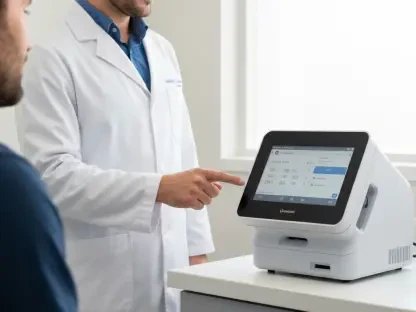Telehealth has emerged as a transformative force in healthcare, reshaping how services are delivered, particularly in dermatology. This transformation is most evident in Australia, where telehealth is bridging significant gaps in access to dermatological care, especially for individuals residing in rural and remote areas. The increasing demand for dermatological services has been met with lengthy wait times for appointments in urban areas and a complete lack of access in remote regions. Enter Virtual Dermatology, an initiative that substantially diminishes these wait times to a mere week. Spearheaded by Dr. Francis Lai, a prominent name in health-tech innovation, this platform harnesses modern technology to offer rapid and reliable dermatological consultations, symbolizing a shift towards more equitable healthcare delivery within the domain of specialties such as dermatology.
The service’s inception was driven by the necessity to address inefficiencies in traditional consultation models. By leveraging telecommunication technologies, Virtual Dermatology provides patients quick access to specialists, irrespective of geographical barriers. This immediate accessibility has proven crucial in catering to the dermatological needs of Australians, who may otherwise face prolonged waiting periods. The advantage of virtual consultations extends beyond just speed; it significantly enhances patient satisfaction, as personalized care is now accessible from the comfort of one’s home. Young patients, in particular, find this medium conducive, leading to more candid discussions on conditions like acne, which they might otherwise hesitate to address in a conventional setting. Consequently, the implementation of telehealth in dermatology not only optimizes access but also fosters effective communication between clinicians and patients, laying the groundwork for superior healthcare outcomes.
Innovative Solutions for Dermatological Access
The innovative approach of Virtual Dermatology underscores a fundamental shift in healthcare delivery, emphasizing efficiency and convenience in patient-doctor interactions. By addressing persistent logistical challenges, the platform serves as a pivotal solution, ensuring dermatological consultations are timely and effective. At its core, the initiative aligns the interests of patients, administrative personnel, and healthcare professionals, establishing streamlined workflows that prioritize patient-centric care. Consequently, the service has garnered credibility and trust within the general practice community, overcoming initial skepticism regarding the efficacy of remote consultations.
The subsequent rapid expansion of Virtual Dermatology reflects its effectiveness, with increasing numbers of dermatologists and consultations integrated into the platform. This growth is a testament to the credibility and robustness of the model, supported by testimonials from both patients and practitioners. With the introduction of telehealth, dermatologists can now cater to a broader audience, providing expert advice and solutions without requiring physical presence. The adoption of this technology-centric model has been instrumental in not only improving service delivery but also enriching the overall patient experience. As a result, telehealth continues to redefine dermatological care in Australia, facilitating seamless access to specialized healthcare.
Moreover, the service stands as a beacon of inspiration for further technological advancements in medical practice. With the integration of artificial intelligence on the horizon, there are endless possibilities for enhancing clinical efficiency and effectiveness. Dr. Lai’s efforts in refining dermatological care through telehealth exemplify the potential for digital innovation to revolutionize traditional healthcare paradigms. Acknowledging the profound impact of such models, healthcare systems worldwide are likely to observe and possibly emulate Australia’s steps towards more dynamic healthcare ecosystems.
Expanding Horizons with Advanced Technology
As Australia’s dermatological landscape evolves, future prospects focus on expanding telehealth services to include critical areas such as skin cancer management. Recognizing skin cancer’s prevalence, Virtual Dermatology intends to incorporate necessary measures within its telehealth framework. This involves leveraging cutting-edge technologies to offer comprehensive care ranging from early detection to continuous monitoring and follow-up consultations. The exploration into integrating and refining the use of artificial intelligence highlights the commitment to align technological advancements with clinical precision. Such initiatives aim to improve diagnostic accuracy and treatment recommendations, ensuring patients receive optimal care aligned with contemporary medical advancements.
Adapting telehealth solutions to include AI amplifies the platform’s capability to support dermatologists in delivering top-notch care. However, implementing these technologies requires careful consideration, as they should serve to enhance, rather than replace, the human touch critical to patient care. Dr. Lai emphasizes that the prudent application of AI is essential, ensuring it reinforces workflow efficiencies and aids in reaching clinical conclusions. These developments reflect a progressive journey where telehealth and AI collaboratively work to optimize healthcare delivery in dermatology, transforming traditional practices into more adaptive and responsive frameworks, thus setting new benchmarks for the medical industry.
Looking forward, the ongoing development within telehealth signifies an era where healthcare delivery models continuously adapt to meet patients’ needs effectively. The intersection of technology and healthcare offers a promising path, with Virtual Dermatology leading by example. As innovations continue to unfold, the potential for telehealth is limitless, offering unprecedented opportunities to reshape dermatological care. Stakeholders within this space are urged to actively engage in these advancements, ensuring technology serves as a pivotal enabler in promoting accessible and high-quality medical service delivery.
The Way Forward for Dermatology in Australia
Telehealth has revolutionized healthcare delivery, especially in dermatology, with its significant impact felt in Australia. It’s particularly beneficial in bridging the gap in dermatological services for those residing in rural and remote regions. Longer wait times for dermatological appointments plague urban areas, while remote regions often face non-existent access. Virtual Dermatology emerges as a solution, reducing these wait times to about a week. Led by Dr. Francis Lai, a respected innovator in health-tech, the platform utilizes cutting-edge technology for swift, reliable consultations, marking a shift towards more equitable healthcare in specialties like dermatology.
Its creation was spurred by the need to rectify inefficiencies in traditional models of consultation. By employing telecommunication advancements, Virtual Dermatology ensures quick specialist consultations regardless of location. This immediacy is vital, offering Australians faster services and enhancing patient satisfaction by providing personalized care from home. Enabling open discussions, especially among younger patients about concerns like acne, the service not only improves access but also nurtures communication between patients and clinicians for better health outcomes.









